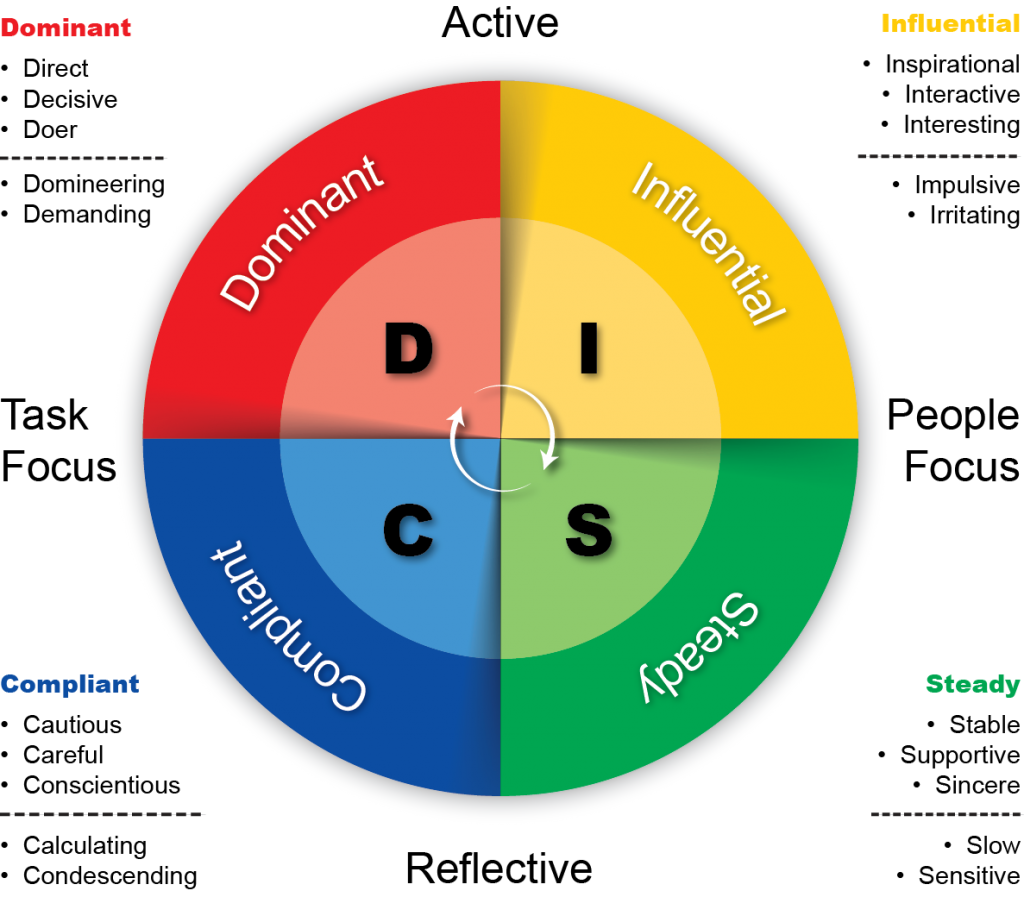If sales is part of your job description – and especially you’re managing sales teams – you’ve probably thought about your style or approach to selling. But have you thought about your customer’s approach to buying? If not, you might want to invest some time exploring how to use DiSC in the sales process.
People like to buy – in a way that’s comfortable for them
We all know the pithy (and accurate) line that “people don’t like to be sold to, but they love to buy.” It’s true of course but I think there’s more to it than that. People like to buy in a way that is comfortable for them.
And this is where DiSC comes in. There is no shortage of psychometric profiles to use, but this one is great for this particular job. It essentially highlights how we like to be communicated with – and therefore how we like to buy.
Birds of a feather
I was asked to run a workshop on DiSC for a sales team of c60 a while back and hit upon a really simple, practical and valuable approach to this.
Firstly, I split the group into the 4 DiSC quadrants. If you’re not familiar, these are:

Top Tip: If you want a quick and easy way to do this, firstly split the room by asking everyone who is decisive to go to one end and if they’re more considered to go to the other. As a rule, if people aren’t sure whether or not they are decisive … Then split both groups the other way, asking if they tend to worry about other people’s feelings – or not.
The $64,000 questions
Where and when did the phrase ‘a $64,000 question’ originate? My guess is that it was decades ago, in which case, surely it should be adjusted for inflation?
Anyway, the big questions I put to the group were this:
How would someone sell more stuff to you?
What sales approach would rub you up the wrong way?
I didn’t want to go into what people would be selling, or whether it was in a work context or home – that would’ve obscured the point. I wanted them to think very naturally about how a salesperson – any salesperson – should approach them.
Each group listed a handful of ‘sales dos and don’ts’ on a flipchart and then took it in turns to share that with the rest of the group.
The results were illuminating to say the least.
Quadrant 1: High Dominant
Do:
- Be direct & get to the point quickly
- Show me how I can win
- Ask me for the business
Don’t:
- Be overly familiar – I’m in charge
- Make claims without the proof to back it up
- Be frivolous
Quadrant 2: High Influential
Do:
- Keep the energy high
- Show an interest in me as a person
- Sell me the vision
Don’t:
- Talk about yourself too much
- Be too serious
- Focus too much on detail
Quadrant 3: High Steadiness
Do:
- Take time to get to know me
- Establish a personal connection
- Be patient
Don’t:
- Rush me into a decision
- Be impersonal
- Be too focussed on ‘the deal’
Quadrant 4: High Compliant
Do:
- Stick to business
- Lead with facts and detail
- Be thoroughly prepared with written materials & proof
Don’t:
- Try to wave away questions / criticisms / errors
- Generalise
- Waste time ‘building rapport’ – I’m not interested in your dog / kids
The one thing that jumps out at you
As each group presented what they’d written on their flip chart some secondary points showed up straight away.
It was clear how refreshing each group found it to work exclusively with other people just like them – with no spanners in the works. The energy-shift was palpable.
Then it was noticeable how tribal things became with each group aiming a fair dose of well-meaning banter at other groups and especially those in the opposite corner.
And then the big lesson began to emerge. The one that makes people more money.
You say potato, I say…
The big thing was that each list of ‘never do this’ advice would have worked fantastically well for them – but back-fired horribly for the group in the opposite corner.
The ‘nailed on’ way to sell more to High Ds – would have had the High S brigade reaching for the big red X button – and vice versa.
And exactly the same for the High Is and Cs.
And that’s the problem you’ve got
If you have a personal style of sales, especially if you’ve been doing it for long enough to settle into a pattern, you probably have the same sales process for everyone.
And that means that you’ll click straight off the bat with 25% of people.
The 25% of people in the diagonally opposite quadrant to you will be actively wound up the wrong way – and as for the rest, it’ll be very much hit or miss.
Now this isn’t necessarily a problem if all your customers are a similar DiSC type – which is similar to yours.
But if they’re not, you will be missing out on a lot of potential customers that could be a great fit for your business.
Best regards,
Tim
P.S. Want some help applying this to your business? Here’s how to get in touch:
- Book a DiSC discovery call
- Ask for a call-back
- Take my business self-assessment test
- WhatsApp 07825 589333





